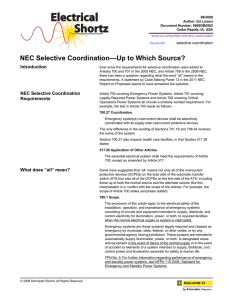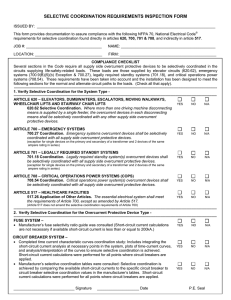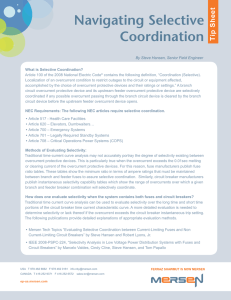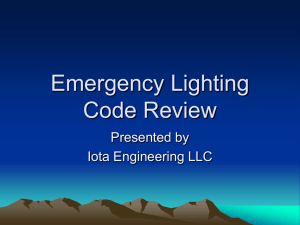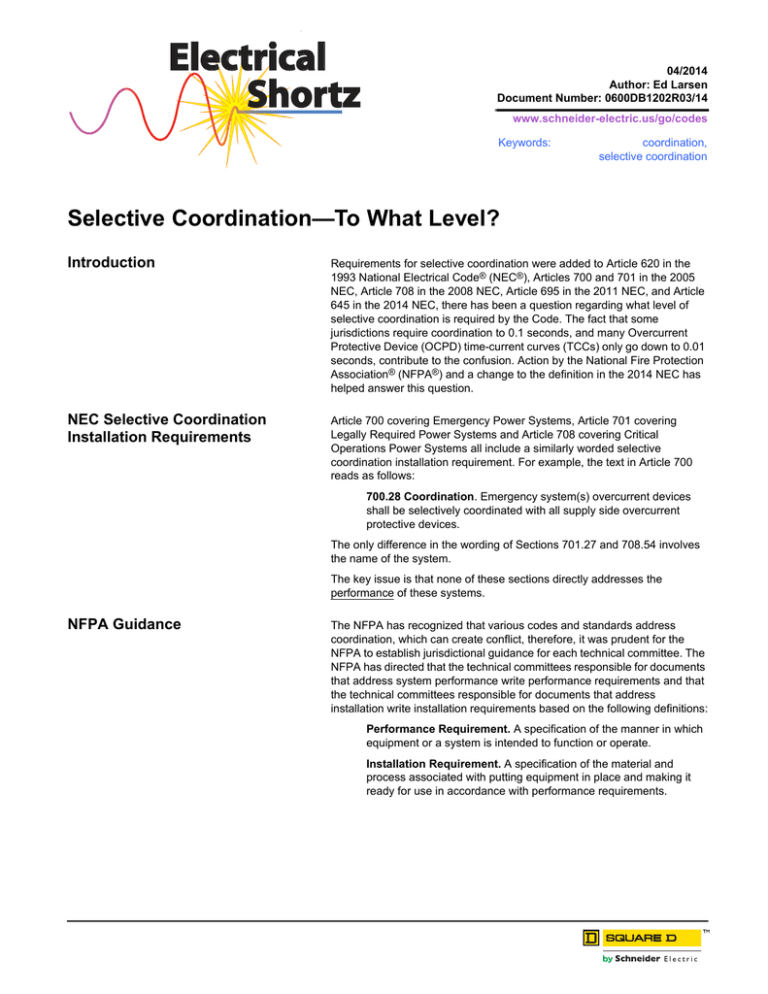
Electrical
Shortz
04/2014
Author: Ed Larsen
Document Number: 0600DB1202R03/14
www.schneider-electric.us/go/codes
Keywords:
coordination,
selective coordination
Selective Coordination—To What Level?
Introduction
Requirements for selective coordination were added to Article 620 in the
1993 National Electrical Code® (NEC®), Articles 700 and 701 in the 2005
NEC, Article 708 in the 2008 NEC, Article 695 in the 2011 NEC, and Article
645 in the 2014 NEC, there has been a question regarding what level of
selective coordination is required by the Code. The fact that some
jurisdictions require coordination to 0.1 seconds, and many Overcurrent
Protective Device (OCPD) time-current curves (TCCs) only go down to 0.01
seconds, contribute to the confusion. Action by the National Fire Protection
Association® (NFPA®) and a change to the definition in the 2014 NEC has
helped answer this question.
NEC Selective Coordination
Installation Requirements
Article 700 covering Emergency Power Systems, Article 701 covering
Legally Required Power Systems and Article 708 covering Critical
Operations Power Systems all include a similarly worded selective
coordination installation requirement. For example, the text in Article 700
reads as follows:
700.28 Coordination. Emergency system(s) overcurrent devices
shall be selectively coordinated with all supply side overcurrent
protective devices.
The only difference in the wording of Sections 701.27 and 708.54 involves
the name of the system.
The key issue is that none of these sections directly addresses the
performance of these systems.
NFPA Guidance
The NFPA has recognized that various codes and standards address
coordination, which can create conflict, therefore, it was prudent for the
NFPA to establish jurisdictional guidance for each technical committee. The
NFPA has directed that the technical committees responsible for documents
that address system performance write performance requirements and that
the technical committees responsible for documents that address
installation write installation requirements based on the following definitions:
Performance Requirement. A specification of the manner in which
equipment or a system is intended to function or operate.
Installation Requirement. A specification of the material and
process associated with putting equipment in place and making it
ready for use in accordance with performance requirements.
Selective Coordination—To What Level?
Electrical Shortz
NFPA 99 Performance
Requirements
0600DB1202R03/14
04/2014
The 2012 edition of the NFPA 99 Health Care Facilities Code defines an
essential electrical system as (emphasis added):
A system comprised of alternate sources of power and all connected
distribution systems and ancillary equipment, designed to ensure
continuity of electrical power to designated areas and functions of a
health care facility during disruption of normal power sources, and
also to minimize disruption within the internal wiring system.
The following performance requirement for Types 1, 2 and 3 essential
electrical systems is stated in clauses 6.4.2.1.2, 6.5.2.1.1 and 6.6.2.1.1:
Overcurrent protective devices serving the essential electrical
system shall selectively coordinate for the period of time that a fault's
duration extends beyond 0.1 second.
Annex A goes on to explain in clauses A.6.4.2.1.2, A.6.5.2.1.1 and
A.6.6.2.1.1that:
It is important that the various overcurrent devices be coordinated,
as far as practicable, to isolate faulted circuits and to protect against
cascading operation on short-circuit faults. In many systems,
however, full coordination could compromise safety and system
reliability. Primary consideration also should be given to prevent
overloading of equipment by limiting the possibilities of large current
inrushes due to instantaneous reestablishment of connections to
heavy loads.
2014 NEC Changes to Article 517
Section 700.28 impacts health care facilities, in that Section 517.26 now
states:
517.26 Application of Other Articles. The life safety branch of the
essential electrical system shall meet the requirements of Article
700, except as amended by Article 517.
Article 517 has amended the requirements of Article 700 by adding the
following text to correlate with NFPA 99:
517.30 Essential Electrical System for Hospitals.
(G) Coordination. Overcurrent protective devices serving the
essential electrical system shall be coordinated for the period of time
that a fault's duration extends beyond 0.1 second.
Exception No. 1: Between transformer primary and secondary
overcurrent protective devices, where only one overcurrent
protective device or set of overcurrent protective devices exists on
the transformer secondary.
Exception No. 2: Between overcurrent protective devices of the
same size (ampere rating) in series.
Informational Note: The terms coordination and coordinated as used
in this section do not cover the full range of overcurrent conditions.
NFPA 110 Performance
Requirements
NFPA 110 is the Standard for Emergency and Standby Power Systems.
Before discussing the NFPA 110 requirements, let's start by understanding
the scope of the standard (emphasis added):
1.1 Scope. This standard covers performance requirements for
emergency and standby power systems providing an alternate
source of electrical power to loads in buildings and facilities in the
event that the primary power source fails.
2
© 2012–2014 Schneider Electric All Rights Reserved
0600DB1202R03/14
04/2014
Selective Coordination—To What Level?
Electrical Shortz
The 2012 edition of the NFPA 110 defines an emergency power supply
system (EPS) as (emphasis added):
A complete functioning EPS system coupled to a system of
conductors, disconnecting means and overcurrent protective
devices, transfer switches, and all control, supervisory, and support
devices up to and including the load terminals of the transfer
equipment needed for the system to operate as a safe and reliable
source of electric power.
This definition is clarified by the drawing in Appendix B.1(a):
Full capacity primary
power sources
Alternate source
generator(s)
Main
OCD
Emergency
power supply (EPS)
Transformer
Non-EPSS
loads
Generator
Overcurrent device with
switching mechanism (OCD)
EPSS
Load 1
EPSS
Load 2
Automatic transfer switch
EPSS
Load 3
Emergency power supply system (EPSS)
Automatic or manual
transfer device
The standard requires the following:
6.5 Protection.
6.5.1 General. The overcurrent protective devices in the EPSS shall
be coordinated to optimize selective tripping of the circuit overcurrent
protective devices when a short circuit occurs.
6.5.2 Short Circuit Current. The maximum available short circuit
current from both the utility source and the emergency energy
source shall be evaluated for the ability to satisfy this coordination
capability.
Annex A goes on to explain in clause A.6.5.1 that:
It is important that the various overcurrent devices be coordinated,
as far as practicable, to isolate faulted circuits and to protect against
cascading operation on short circuit faults. In many systems,
however, full coordination is not practicable without using equipment
that could be prohibitively costly or undesirable for other reasons.
Primary consideration also should be given to prevent overloading of
equipment by limiting the possibilities of large current inrushes due
to instantaneous reestablishment of connections to heavy loads.
2014 NEC Definition Change
A change has been made to the definition of selective coordination in
Article 100 that impacts what the NEC means when it uses this term.
Coordination (Selective). Localization of an overcurrent condition
to restrict outages to the circuit or equipment affected, accomplished
by the selection and installation of overcurrent protective devices
and their ratings or settings for the full range of available
overcurrents, from overload to the maximum available fault current,
and for the full range of overcurrent protective device opening times
associated with those overcurrents.
© 2012–2014 Schneider Electric All Rights Reserved
3
Selective Coordination—To What Level?
Electrical Shortz
0600DB1202R03/14
04/2014
Obviously this revised definition will necessitate a change in the use of the
term “selective coordination” in NFPA 99. It will also limit the ability to use
the requirements in NFPA 110 to design systems requiring emergency and
standby power in those jurisdictions that have adopted the 2014 NEC.
Specifying the Level of Selective
Coordination
In jurisdictions or applications where NFPA 99 applies, coordination of the
essential electrical system should be required to 0.1s. This means that the
TCCs of OCPDs that are in series with one another in an essential electrical
system should not overlap or cross one another for fault currents that would
cause the upstream device(s) to operate in greater than 0.1s.
In jurisdictions that have yet to apply the 2014 edition of the NEC,
coordination of the emergency, legally required, critical operation and
certain fire pump power supply systems should be at least optimized as far
as practicable.
In such applications, selective coordination back to the alternate source is
what is required by NFPA 99 and 110 and editions of the NEC prior to 2014.
This is not to say that these are the best coordination performance levels
that can or should be achieved and that coordination up to the utility should
be ignored. These are minimum performance requirements, as is the case
with any code or standard. There is nothing that prevents or discourages
achieving a higher level of performance. Achieving higher performance is a
matter of an engineer designing the entire system for appropriate
performance.
Coordination Specification —
Time vs. “Total”
Some engineers have specified coordination down to 0.01s, probably
because many OCPD TCCs are cut off below that time, but doing so does
not guarantee total coordination.
Current limiting OCPDs have the ability to totally clear faults that are in their
current limiting range in one half cycle or less, which on a 60 Hz system is
less than 0.01s. Trying to use TCCs that are cut off at 0.01s to evaluate
coordination if a high fault current event were to occur would be impossible
because the operation of the devices would be “off the graph”. (Note:
Current limiting circuit breaker TCCs may be published down to 0.001s.)
Ratio tables need to be used to evaluate current limiting fuse coordination
below 0.01s.
But even standard molded case circuit breakers begin operating in far less
than 0.01s, sometimes in less than 0.001s. The moment the contacts part
on the downstream circuit breaker, the dynamic impedance of the resulting
arc will limit the level of let-through current that will flow through the
upstream device. As TCCs tell nothing about let-through current, in order to
evaluate the total coordination of two circuit breakers when the prospective
fault current exceeds the minimum instantaneous trip point of the upstream
circuit breaker, coordination tables must be employed. (Note: This is the
same principle as fuse ratio tables.)
Engineers who want their systems to be totally, completely and fully
coordinated should specify “selective coordination”. If coordination to a
lesser level, such as 0.1s, is desired, they should specify the level they want
using the word “coordination”.
4
© 2012–2014 Schneider Electric All Rights Reserved
0600DB1202R03/14
04/2014
Summary
Selective Coordination—To What Level?
Electrical Shortz
In health care facilities, NFPA 99-2012 requires that the essential electrical
system be coordinated to 0.1s for all types of fault current generated by the
alternate source.
In power systems requiring emergency or standby power where the 2014
NEC has yet to be adopted, NFPA 110-2010 requires that the OCPDs
feeding the automatic transfer switch(s) be selectively coordinated to the
extent practicable.
In Articles 620, 645, 695, 700, 701 and 708 systems where selective
coordination is required and the 2014 NEC has been adopted, selective
(total) coordination will be required.
Specifying selective coordination with a time value such as 0.01s is not the
same as total coordination. If total coordination is what is desired, then
“selective coordination” should be specified. Circuit breaker coordination
tables and fuse ratio tables may need to be employed to determine selective
coordination depending on where the level of fault current is with respect to
the operating characteristics of the upstream OCPD.
© 2012–2014 Schneider Electric All Rights Reserved
5
Selective Coordination—To What Level?
Electrical Shortz
For More Information
0600DB1202R03/14
04/2014
Guidance on Coordinating Requirements with Other NFPA Technical
Committees, NFPA Standards Council Meeting Final Minutes, October 1920, 2010, attachment 10-10-23
NEC Selective Coordination–Up to Which Source?, Schneider Electric data
bulletin 0600DB0902
Guide to Power System Selective Coordination, Schneider Electric data
bulletin 0100DB0603
Visit the Schneider Electric North America Codes and Standards Electrical Shortz website at:
http://www.schneider-electric.us/support/codes-and-standards/codes-standards-technical-library1/product-documentation/
Schneider Electric USA, Inc.
1415 S. Roselle Road
Palatine, IL 60067 USA
1-888-778-2733
www.schneider-electric.us
“Electrical Shortz” are produced by the Schneider Electric North America Codes and
Standards Group. These documents provide general guidance on a specific issue.
Circumstances regarding particular installation issues may need further consideration.
© 2012–2014 Schneider Electric All Rights Reserved
Schneider Electric and Square D are trademarks owned by Schneider Electric
Industries SAS or its affiliated companies. All other trademarks are the property of
their respective owners.

